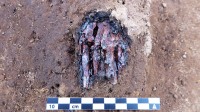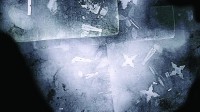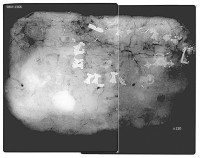 Archaeologists excavating the Fregerslev Viking grave south of Hørning near Skanderborg in Jutland, Denmark, have discovered a bundle of arrowheads at the bottom of the grave. The bundle appears to contain six heart-shaped iron arrowheads. There’s a layer of black organic material at the pointed end of the arrowheads that archaeologists believe to be the remnants of the quiver, long-since decayed.
Archaeologists excavating the Fregerslev Viking grave south of Hørning near Skanderborg in Jutland, Denmark, have discovered a bundle of arrowheads at the bottom of the grave. The bundle appears to contain six heart-shaped iron arrowheads. There’s a layer of black organic material at the pointed end of the arrowheads that archaeologists believe to be the remnants of the quiver, long-since decayed.
These were probably not weapons of war. They were likely used for hunting deer and wild boar. It’s even more evidence of what an elevated position the Fregerslev Viking held in society. Only the elite would have had the opportunity and means to go hunting, so the bundle of arrows buried with him are symbols of high status.
 Arrowheads are very rare discoveries in Viking rider graves. A whole quiver of them is practically unheard of, and the Skanderborg Museum archaeologists are justifiably elated by the find. As with the other rich discoveries in the grave, the arrowheads were not fully excavated in situ. They were removed in a soil block earlier this week and taken to the museum laboratory to be X-rayed. The X-ray should show archaeologists how many arrows are in the bundle and give them a roadmap for excavation of the block in the lab.
Arrowheads are very rare discoveries in Viking rider graves. A whole quiver of them is practically unheard of, and the Skanderborg Museum archaeologists are justifiably elated by the find. As with the other rich discoveries in the grave, the arrowheads were not fully excavated in situ. They were removed in a soil block earlier this week and taken to the museum laboratory to be X-rayed. The X-ray should show archaeologists how many arrows are in the bundle and give them a roadmap for excavation of the block in the lab.
Reaching the bottom of the rider’s grave is an important milestone. It’s only 28 centimeters (11 inches) deep at the deepest point — it’s a miracle that it wasn’t destroyed by agricultural activity — but the sheer amount of corrosion from metals including gold, bronze and silver visible on the surface of the trench indicates there are still an extraordinary number of expensive grave goods under there.
 Experts are still in the process of X-raying the soil blocks that have already been removed. One lifted from the foot of the grave near the block that was already found to contain star-shaped bridle fittings contains even more fittings. The ones showing as bright white in the X-ray are silver or silver-plated. There are new types of hardware in the block that archaeologists believe to be decorative elements from a harness and/or stirrups. There is no sign of the stirrups themselves, however, which the team are keen to find. They hope excavation and X-rays of other soil blocks will find evidence of the stirrups.
Experts are still in the process of X-raying the soil blocks that have already been removed. One lifted from the foot of the grave near the block that was already found to contain star-shaped bridle fittings contains even more fittings. The ones showing as bright white in the X-ray are silver or silver-plated. There are new types of hardware in the block that archaeologists believe to be decorative elements from a harness and/or stirrups. There is no sign of the stirrups themselves, however, which the team are keen to find. They hope excavation and X-rays of other soil blocks will find evidence of the stirrups.
The shiny things aren’t the only archaeological treasures in the grave. Archaeologists will be using the latest and greatest technology to analyze the soil for microscopic remains that will allow them to identify species of plants that were once inside the grave but have decayed along with the human and horse remains. They’re also going to look for DNA in the soil. German archaeologists have recently had a breakthrough in this cutting-edge technology, successfully isolating prehistoric DNA from the soil and clay of caves with nary a bone or tooth in sight.
Even if I learned with ‘Pilespidser’ a cool new Danish word, I wonder if those depicted brown shafts are actually the arrow ‘spidser(s)’. Also, that ground seems to be a rather acidic one, hence to gain undisturbed DNA might be a bit of a problem. Were there signs that anything got cremated ? ‘Vikingers’ seem to like burning down things, according to Ahmad ibn Fadlan, who wrote in 922 AD:
..I was told that when their chieftains die, the least they do is to cremate them. I was very keen to verify this, when I learned of the death of one of their great men. They placed him in his grave (qabr) and erected a canopy over it for ten days, until they had finished making and sewing his [funeral garments]. In the case of a rich man, they gather together his possessions and divide them into three, one third for his family, one third to use for [his funeral] garments, and one third with which they purchase alcohol. […] I could see that he had turned black because of the coldness of the ground. They had also placed alcohol, fruit and a pandora (çtunb¢ur) beside him in the grave, all of which they took out. Surprisingly, he had not begun to stink and only his colour had deteriorated. […] Then the deceased’s next of kin approached and took hold of a piece of wood and set fire to it. […] The wood caught fire, and then the ship, the pavilion, the man, the slavegirl and all it contained. A dreadful wind arose and the flames leapt higher and blazed fiercely..
No horses were mentioned, but horse burials and ‘ryttergraver‘ were -not at all- unheard of in eastern Europe. To find anything ‘exotic’ in Denmark would be fantastic (unfortunately, I simply don’t know, if horse burials are ‘exotic’ in Scandinavia).
Hi, just to say big fans of your blog, if you ever fancy writing a bit of Normandy history as a guest blogger on Normandy Then and Now we would be delighted.
Kind regards,
Pippa
It is really neat to hear about what was found. Keep me posted on your progress.
Stout arrowheads and shafts. They look more than a little heavy for deer, but for bear and boar they look like just the thing.
The context almost make me think they may have been specially produced as a grave good? You don’t send man to the afterlife with everyday arrows, especially a Viking. He’s got a lot of fighting, monster slaying, and hunting ahead of him. Your common Earth arrow isn’t going to cut it in Valhalla.
From what I can see the midsection of the head is broad in ratio to the point. On one of the heads you can make out the angle of the lobes on the head to the shaft. These arrows were meant to hit hard, twist deep through tissue and organs, with the lobes designed to keep it from coming out the way it went in. Nothing on four or two feet would have been safe from a man with a quiver of those.
Ironically, hunting points today are still modeled on much the same principles. Why reinvent the arrowhead?